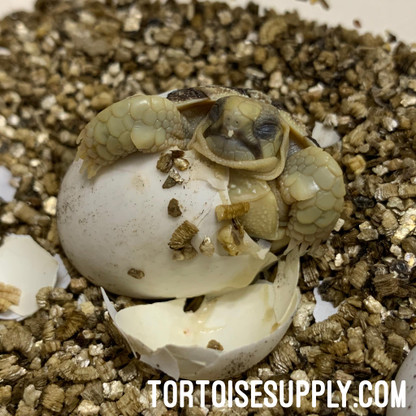- Home
- Tortoises For Sale
- Baby Tortoises For Sale (All Species)
- Baby Egyptian Tortoise
- Home
- Tortoises For Sale
- Egyptian Tortoises For Sale
- Baby Egyptian Tortoise
Baby Egyptian Tortoise
Out of Stock
Product Reviews
Description
*These Egyptian tortoises hatched here from our adults*
Common Name: Egyptian Tortoise
Scientific Name: Testudo Kleinmanni
Current Size: 1"+/-
Average Adult Size: 3.5-5" (females larger)
Area of Origin: Libya/Egypt/Israel
Description: Very light sandy tan color with bold black markings on the shell. This is an extremely rare tortoise in the United States and in the wild, and is considered critically endangered. Egyptian tortoises are thought to tolerate (and prefer) slightly warmer overall temperatures than other tortoises in the testudo group. Egyptians are somewhat of a high domed tortoise. As babies, Egyptian tortoises look very similar to baby hermanns and greek tortoises.
Habitat: These animals live in sandy desert areas with high daytime temperatures. Babies generally live in washes and lower areas that maintain a little more moisture and humidity, and adults are more open-dune tortoises. There is some debate whether this species hibernates naturally, and it's likely that some areas do go down for short periods of time in the winter, while warmer areas stay active during the coldest months (which aren't that cold). Summer highs up to 120 degrees can be tolerated as long as there is a cooler, shaded retreat the tortoise can get into. In hot climates, they will spend much of the summer days in burrows or simply buried under an inch or two of earth.
Diet: This tortoise is naturally a browser, eating broadleaf weeds and low leaves from bushes and shrubs. In captivity, Egyptian tortoises will graze on leafy weeds, dandelion, clover, and most other leafy greens provided to them. As babies, we focus more on feeding them a wide mix of leafy greens (spring mix). Vegetables can be added to the diet for variety, but fruit should generally be avoided or given as no more than 5-10% of the diet.
Our Current Care: During cooler weather or indoors, these tortoises are kept indoors on a decomposed granite/oyster shell mix substrate kept mostly dry with a humid hidebox that they can get into at night. A fogger comes on (automatically) each morning for about 2 hours, starting a half hour before the lights kick on. Temperatures in the room fluctuate between 65 at night up to 85-90 during the day. Diet consists of spring mix on a daily basis, with moistened Mazuri tortoise diet mixed into the spring mix a few times a week. We sprinkle the food lightly with a calcium supplement 3 times a week. The tortoises are removed from their enclosure and soaked in a separate 1/4" deep pan of warm water generally 7 days a week for 30 minutes each time. Being a warmer climate tortoise, they should have good lighting, and they need lights on during the day and off at night to maintain a normal day/night cycle. We use full spectrum UVB lights, which we suggest for the growth of pretty, healthy tortoises, and use spot bulbs in a small part of the enclosure to give them a "hot spot" around 100 degrees that they can get into if they want to warm up. This is one species we absolutely suggest using a 100W or higher mercury vapor bulb for their lighting. Anything other than that will not be intense enough. These tortoises like very bright lighting.
 Loading... Please wait...
Loading... Please wait...


